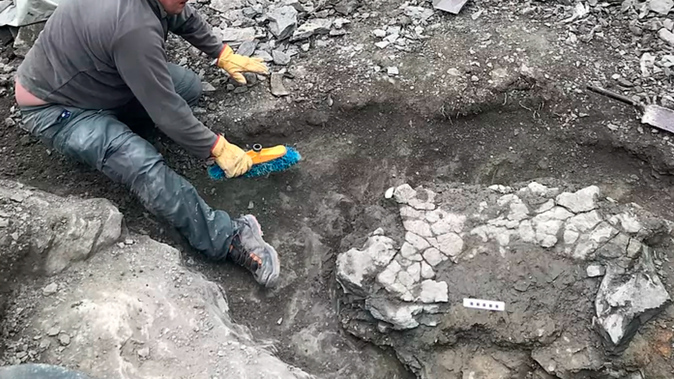80-million-year-old dinosaur eggs discovered in China
Researchers from the Miquel Crusafont Catalan Institute of Paleontology, the Conca Dellà Museum and the Czech University of Masaryk Brno (MU) have described in the journal Scientific Reports
the new species of sea turtle from about 83 million years ago
Leviathanochelys aenigmatica
.
Its scientific name means "enigmatic leviathan turtle", in reference to Leviathan, a biblical marine beast of enormous dimensions due to the peculiar skeletal characteristics of this animal, which perplexed the paleontologists who excavated it.
"The surprise was huge. The truth is that the remains of marine reptiles in the Pyrenees are not common, and less of these dimensions," explains Oscar Castillo, a researcher at the Institut Català de Paleontologia Miquel Crusafont (ICP) and the Conca Dellà Museum. (MCD), who signs the research article.
The fossil remains of this reptile, of which only part of its shell and pelvis are known,
allow us to estimate a total length of the shell of 3.7 meters long
.
It is the largest sea turtle in Europe and the second largest in the world, only surpassed by the Archelon genus of North America, which measured up to four and a half meters in length.
"The morphology of the fossils was also very curious, in the research process we were clear that it was a new species for science," says the paleontologist.
The scientific study suggests that
Leviathanochelys
is one of the oldest representatives of the Chelonioidea, the group that includes all living sea turtles.
Beyond its colossal dimensions, the new species of turtle presents
protuberances in the front part of the pelvis never seen in any other turtle, neither terrestrial nor marine.
The research team believes that these bony projections, linked to the muscles that controlled the contraction of the animal's belly, could have participated in functions related to the respiratory system of
Leviathanochelys
.
The anatomical features of this new species suggest that it had a pelagic lifestyle and was capable of reaching great depths.
Recreation of the Leviathanochelys aenigmatica
In addition to Castillo, the team that has carried out the research includes paleontologists Àngel H. Luján (ICP and MU), Àngel Galobart (ICP and MCD) and Albert Sellés (ICP and MCD).
The discovery of the fossil remains took place in July 2016 by a hiker
near Cal Torrades, in the municipality of Coll de Nargó (Alt Urgell), who notified the discovery to Espai Dinosfera, a center for the dissemination of paleontology in the Pyrenees linked to the Conca Dellà Museum (in Isona, Pallars Jussà).
A team made up of research personnel and the Archaeological and Paleontological Heritage Service of the Generalitat of Catalonia went to the place of the discovery and organized an emergency intervention to preserve the remains that had been exposed in the open air.
Subsequently, they were deposited in the Conca Dellà Museum waiting to be studied.
As a result of the preliminary study carried out by Oscar Castillo in the framework of his master's thesis, new excavation campaigns were carried out at the site that allowed the recovery of the posterior part of the shell and an almost complete pelvis almost 90 cm wide.
The fossil remains of
Leviathanochelys
will be permanently exhibited in the Coll de Nargó Dinosfera Space, a center that is part of Dinosaurs of the Pyrenees, a network of museums and interpretation centers promoted by the Institut Català de Paleontologia Miquel Crusafont to disseminate the extraordinary paleontological heritage of the Pyrenees and found within the UNESCO Global Geoparc ORIGENS.
The fossil record of the Pyrenees is known worldwide for the
numerous remains of dinosaurs that have been excavated and that have made it possible to describe new species
for science.
In recent years, three unique species of these animals have been described in this region, such as the gigantic
Abditosaurus
, a titanosaur over 15 meters long, the tiny and elusive carnivore
Tamarro
, and the primitive hadrosaur
Fylax
.
These species are some of the last representatives of dinosaurs that lived in Europe about 70 million years ago, shortly before they became extinct throughout the world.
According to the criteria of The Trust Project
Know more

